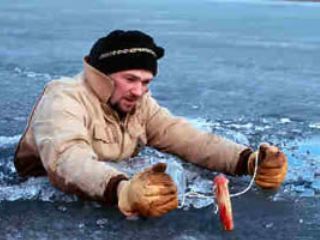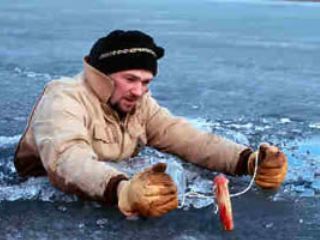
While I am not an ice fisherman, I learned a lot about it while working at an outdoors retailer. By listening and learning from fellow associates and even some customers, I came to know enough about ice fishing to help anyone find what they need for a good day out on the ice. Ice fishermen are the true die-hards of the sport, and some even love it so much that they brave ice only three inches thick just to get a few days’ head start on the water. While this is not advised, as it is not safe to head out onto ice that isn’t at least four inches thick, some do and, unfortunately, accidents do happen. Due to some of the stories I’ve heard about ice fishing tragedies, I wanted to detail some safety precautions and even tools you can utilize to ensure that your own ice fishing trips go smoothly and you make it home safe.
You can never trust the ice completely. Even if someone says they went out yesterday and it was fine, or someone just sped by you on an ATV to get out to their shanty, you must always be careful, especially early or late in the season. Rain, warmer weather, and winds all change on a daily basis and can impact the ice severely. As a rule, four inches is preferred if you’re on foot, five inches for a snowmobile or an ATV, and for those who dare to drive a truck out onto the ice, I wouldn’t advise doing so unless there’s a solid twelve inches of ice (though, truth is, I wouldn’t advise it at all). Try not to fish on ice covering moving water, as well as areas near structures such as beaver dams, logs, or any vegetation. Furthermore, remember that the ice near the shore will tend to be weaker, as the shallower water will warm quicker.
Unless you’re one of the frequent, and lucky, ice anglers who own a shanty that you can sit comfortably in while a portable heater keeps you warm, you’ll need to be sure to dress warmly. Thermal underwear, a warm winter hat, and gloves are a must. I’d suggest bringing along an extra pair of gloves, as you’ll be handling wet fish and ice often, so yours might get a little wet, which is no fun. Ice cleats are also a great idea, as they’ll improve your traction on the slick ice, and, if possible, invest in a floatation device. Water-activated life vests or flotation suits are good options. Another piece of equipment that anyone on the ice should have on them at all times is a pair of ice picks. These life-saving tools are usually connected by a cord that hangs around your neck and can mean the difference between drowning and climbing to safety should you fall through.
Lastly, the outdoors can be more enjoyable with a friend, and ice fishing is no exception. Not only do you have someone to talk to, but you also get to employ the old adage, “safety in numbers.” Having someone with you to help out if something should happen is a great idea. If you do, try to walk a few yards apart, so you can spread your weight out. One of you should test the ice a few yards ahead while the other carries the gear. Keep a length of rope on you as well, in case the worst should happen, along with a cell phone. Watch out for each other, especially for signs of hypothermia, such as slurring your words, excessive shivering, or disorientation.
Ice fishing can yield some of the greatest numbers you’ll find on the water, and there’s nothing like frying up dozens of bluegill or crappie fillets at the end of a cold day. However, to ensure that your day doesn’t end in tragedy, take the time to prepare by dressing warm, keeping an eye on the weather, take a friend, and let someone know where you’re going, just to be safe. I’ve heard numerous stories of people falling through the ice and not making it home, and I don’t want to hear any more. Please be safe this winter and good luck on the water!








